There was once a project manager who was a huge fan of the Eisenhower Matrix. She used it to prioritize all of her tasks, and even had a giant poster of the matrix on her office wall.
One day, her boss came in and asked her why she had a picture of a matrix on her wall. She excitedly explained the concept of the Eisenhower Matrix and how it helped her prioritize her tasks.
Her boss, confused, asked her what the “urgent but not important” quadrant was for. The project manager thought for a moment before answering, “Oh, that’s for all the tasks my boss assigns me.”
The boss, taken aback, quickly asked her to move the poster to her home office.
Hey there, fellow productivity enthusiasts!
If you’re like me, you’re always on the lookout for ways to prioritize your tasks and make sure you’re focusing on the most important things first. And if you’re also like me, you’ve probably heard of at least a few different prioritization frameworks out there.
But what are all these frameworks, and how do they compare? Never fear, my friends, because I’m here to break down all the known prioritization frameworks for you.
Comparison Criteria
There are several criteria that can be used to evaluate prioritization methods:
- Effectiveness: Does the method accurately prioritize items based on their importance or value?
- Efficiency: Does the method allow for quick and easy prioritization of items?
- Flexibility: Can the method be customized or adapted to fit the needs of different organizations or projects?
- Transparency: Is it clear how and why items are being prioritized in a certain way?
- Stakeholder buy-in: Do stakeholders agree with and support the prioritization method being used?
- Scalability: Can the method be used to prioritize large numbers of items effectively?
- Sustainable: Can the method be used over the long term without becoming overly burdensome or time-consuming?
- Alignment with goals: Does the method help organizations achieve their goals and objectives?
Urgency/Importance Matrix a.k.a. Eisenhower Matrix
First up, we have the trusty old Eisenhower Matrix. Named after the US President Dwight David Eisenhower, this framework is based on the idea that tasks can be divided into four quadrants based on their urgency and importance. Urgent tasks are those that need to be done immediately, while important tasks are those that will have a significant impact on your goals.
The four quadrants of the Eisenhower Matrix are: urgent and important tasks (do these first),important but not urgent tasks (schedule these for later), urgent but not important tasks (delegate these to someone else), and not urgent and not important tasks (eliminate these if possible).
- Effectiveness: 4/5
- Efficiency: 3/5
- Flexibility: 4/5
- Transparency: 5/5
- Stakeholder buy-in: 3/5
- Scalability: 5/5
- Sustainable: 5/5
- Alignment with goals: 5/5
The ABCDE Method
Next, we have the ABCDE Method, which is similar to the Eisenhower Matrix in that it also divides tasks into four categories. In this case, tasks are assigned a letter based on their relative importance.
A tasks are the most important, while B tasks are slightly less important, and so on. Once you’ve assigned a letter to each task, you can prioritize your to-do list by starting with the A tasks and working your way down to the D and E tasks.
- Effectiveness: 4/5
- Efficiency: 3/5
- Flexibility: 3/5
- Transparency: 5/5
- Stakeholder buy-in: 3/5
- Scalability: 4/5
- Sustainable: 4/5
- Alignment with goals: 4/5
4D Method
Another popular framework is the 4Ds Method, which focuses on identifying the tasks that are: doable(tasks that you can actually complete), delegatable (tasks that someone else can do), deferrable (tasks that can be put off for now), and droppable (tasks that aren’t worth doing at all).
- Effectiveness: 3/5
- Efficiency: 3/5
- Flexibility: 3/5
- Transparency: 5/5
- Stakeholder buy-in: 3/5
- Scalability: 4/5
- Sustainable: 4/5
- Alignment with goals: 4/5
Pareto Principle
Finally, there’s the Pareto Principle, also known as the 80/20 rule. This principle states that roughly 80% of the effects come from 20% of the causes. In other words, a small number of tasks are likely to have the biggest impact on your goals.
To use the Pareto Principle in your prioritization, focus on the 20% of tasks that will give you the biggest bang for your buck. These are the tasks that are most important and should be tackled first.
- Effectiveness: 4/5
- Efficiency: 5/5
- Flexibility: 3/5
- Transparency: 5/5
- Stakeholder buy-in: 4/5
- Scalability: 5/5
- Sustainable: 5/5
- Alignment with goals: 5/5
The MoSCoW Method
This framework categorizes tasks based on their importance in terms of Must, Should, Could, and Won’t. This helps individuals focus on the “must-have” tasks first, while still considering the “should” and “could” tasks for potential inclusion.
- Effectiveness: 4/5
- Efficiency: 4/5
- Flexibility: 4/5
- Transparency: 5/5
- Stakeholder buy-in: 4/5
- Scalability: 4/5
- Sustainable: 4/5
- Alignment with goals: 5/5
The Kano Model
This framework focuses on customer satisfaction and prioritizing tasks based on their potential impact on the customer. Tasks are categorized as “must-have,” “nice-to-have,” and “delighters,” allowing individuals to prioritize tasks that will provide the most value to the customer.
- Effectiveness: 4/5
- Efficiency: 4/5
- Flexibility: 5/5
- Transparency: 4/5
- Stakeholder buy-in: 4/5
- Scalability: 4/5
- Sustainable: 5/5
- Alignment with goals: 5/5
The RICE Method
RICE is a method used to prioritize tasks by ranking them based on how many people or customers will be affected (reach), how much impact they will have (impact), how confident the team is in their ability to complete the task successfully (confidence), and how much effort the task will require (effort). Teams evaluate each task on these four factors, assign a score to each, and give the highest priority to the tasks with the highest scores. This helps teams focus on the most impactful and feasible tasks.
- Effectiveness: 4/5
- Efficiency: 3/5
- Flexibility: 3/5
- Transparency: 4/5
- Stakeholder buy-in: 3/5
- Scalability: 3/5
- Sustainable: 3/5
- Alignment with goals: 4/5
The 1-3-5 Method
The 1-3-5 prioritization method is used to prioritize tasks by assigning a priority level based on the amount of time and resources required to complete them. Tasks that can be completed in one day or less are given a priority of 1, tasks that can be completed in three days or less are given a priority of 3, and tasks that can be completed in five days or less are given a priority of 5. Tasks with the lowest priority (1) are completed first, followed by those with a priority of 3, and then those with a priority of 5. This method helps teams quickly prioritize a large number of tasks.
- Effectiveness: 3/5
- Efficiency: 3/5
- Flexibility: 2/5
- Transparency: 3/5
- Stakeholder buy-in: 2/5
- Scalability: 3/5
- Sustainable: 2/5
- Alignment with goals: 3/5
The ICE Scoring Model
The ICE (Impact, Confidence, Ease) scoring model is a methodology used to evaluate and prioritize initiatives at an organization. It assigns a numerical value to each control based on three factors: Impact, which is the potential financial or reputational impact of an initiative; Confidence, which is the likelihood that the initiative will be successful; and Ease, which is the cost and feasibility of implementing and maintaining the initiative. These scores are then used to prioritize the organization’s initiatives and allocate resources accordingly.
- Effectiveness: 5/5
- Efficiency: 4/5
- Flexibility: 4/5
- Transparency: 5/5
- Stakeholder buy-in: 4/5
- Scalability: 4/5
- Sustainable: 4/5
- Alignment with goals: 5/5
The ONE Thing
The ONE Thing prioritization method is a productivity technique that helps individuals and organizations focus on the most important task at hand by identifying the next thing that they can do that will make all other tasks easier or unnecessary. The method is based on the idea that by focusing on the most important task and completing it, you will be able to achieve more in less time and with less stress. It helps to break down the bigger goals into smaller, more manageable tasks and prioritize them based on the impact they will have on achieving the overall goal.
- Effectiveness: 5/5
- Efficiency: 5/5
- Flexibility: 3/5
- Transparency: 4/5
- Stakeholder buy-in: 4/5
- Scalability: 4/5
- Sustainable: 4/5
- Alignment with goals: 5/5
“1st things 1st”
The “1st things 1st” prioritization method is a way to evaluate tasks based on multiple criteria and get calculated priorities accordingly. To use this method, you’ll need to identify the criteria that are most important to you and evaluate each task on your to-do list based on those criteria. Some common criteria that people use include impact, effort, deadline, importance to long-term goals, dependencies on other tasks, and potential consequences of not completing the task.
For example, let’s say you are a project manager and have a list of tasks that need to be completed for a client. Your criteria might include impact (how important is the task to the success of the project?), effort (how much time and energy will it take to complete the task?), deadline (is the task time-sensitive?), importance to long-term goals (does the task align with your long-term goals for the project?), dependencies (does the task depend on the completion of other tasks?), and potential consequences (what will happen if the task is not completed?).
Using these criteria, you can evaluate each task on your to-do list and assign priorities accordingly. Tasks that are high impact, low effort, and time-sensitive should be your top priority, while tasks that are low impact, high effort, and not as time-sensitive should be lower priority. By using the “1st things 1st” method, you can ensure that you are focusing on the tasks that will have the greatest impact and make the most efficient use of your time and energy.
- Effectiveness: 4/5
- Efficiency: 5/5
- Flexibility: 4/5
- Transparency: 5/5
- Stakeholder buy-in: 4/5
- Scalability: 5/5
- Sustainable: 5/5
- Alignment with goals: 5/5
Introducing 1st things 1st, the ultimate solution for making complex decisions with ease.
With intuitive and smart prioritization tools, you can confidently prioritize options based on your personal preferences and assess them from multiple angles. Customizable templates allow you to align your priorities with your goals, while our AI-powered autosuggestion and fast evaluations equip you for confident and informed decisions.
Don’t struggle with analysis paralysis –
unlock the full potential of your decision-making with 1st things 1st.
So which prioritization method to use then?
I used the “1st things 1st” prioritizer to calculate which prioritization methods are the best and here are the results:

In conclusion, there are many different prioritization frameworks available, each with its own strengths and weaknesses. When choosing a framework, it’s important to consider your own goals and needs, as well as the specific context in which you will be using the framework. Some frameworks, such as the “1st things 1st”, are well-rounded and rated highly in multiple categories, while others, such as the 4D Method, may be more specialized and geared towards certain types of tasks or organizations. Ultimately, the best prioritization framework for you will depend on your own priorities and needs. Happy prioritizing!
Cover photo by Daniel Dan
Disclaimer: the evaluations of each prioritization method were done using Artificial Intelligence and might differ from personal preferences.
